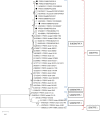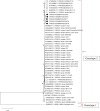Molecular characterisation of porcine reproductive and respiratory syndrome virus from pigs in Kerala
- PMID: 33381629
- PMCID: PMC7749013
- DOI: 10.1007/s13337-020-00634-7
Molecular characterisation of porcine reproductive and respiratory syndrome virus from pigs in Kerala
Abstract
Porcine reproductive and respiratory syndrome (PRRS) caused by an arterivirus is characterised by reproductive disorders in sows, and post-weaning pneumonia and growth reduction in piglets. Though the virus has been detected in Kerala, no systematic study has been carried out to ascertain its genotype and molecular epidemiology. In the present study, 7 PRRS virus (PRRSV) positive samples collected from incidences of PRRS in Kerala during 2017-2019 were subjected to ORF5, ORF7 and Nsp2 gene based reverse transcription polymerase chain reaction and the specific amplicons generated were sequenced. On BLAST analysis it was revealed that all the sequences were of genotype 2 (North American genotype). Phylogenetic analysis of ORF5 sequences, grouped them under subgenotype 4 with close clustering with other isolates from Kerala, Mizoram and Assam. Nsp2 gene sequence based phylogenetic analysis grouped the isolates under subgenotype 3 with similarities to isolates from Mizoram. Phylogenetic analysis based on ORF7, clustered the isolates under study with PRRSV isolates from Mizoram and Meghalaya. In Nsp2 sequences, a 30 amino acid discontinuous deletion was observed. On analysis of amino acid sequences of ORF5 of Kerala isolates and those from India, it was seen that the Kerala isolates showed closer similarity to PRRSV isolates from Assam than to the other Indian isolates. The study reveals that PRRSV strains prevalent in Kerala share close relationship with other PRRSV isolates in India. This may be due to spread of the virus from these regions to Kerala due to animal movement. Concerted efforts should be undertaken to check unauthorized animal movement to control spread of this economically important disease.
Keywords: Nsp2; ORF5; ORF7; PRRSV; Phylogeny; RT-PCR.
© Indian Virological Society 2020.
Figures



References
-
- An TQ, Zhou YJ, Liu GQ, Tian ZJ, Li J, Qiu H, Tong GZ. Genetic diversity and phylogenetic analysis of glycoprotein 5 of PRRSV isolates in mainland China from 1996 to 2006: coexistence of two NA-subgenotypes with great diversity. Vet Microbiol. 2007;123:43–52. doi: 10.1016/j.vetmic.2007.02.025. - DOI - PubMed
LinkOut - more resources
Full Text Sources
Research Materials

